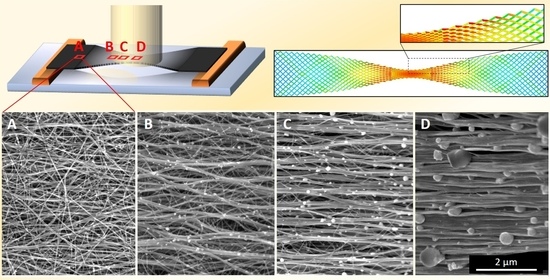Catalyst-Mediated Enhancement of Carbon Nanotube Textiles by Laser Irradiation: Nanoparticle Sweating and Bundle Alignment
Abstract
1. Introduction
2. Results and Discussion
2.1. Laser-Induced Change of Morphology
Modelling the Macrostructural Changes
2.2. Catalyst Sweating
2.2.1. Coarsening of Sweated Nanoparticles
2.2.2. Dependence on Material Class
2.2.3. Carbonaceous Bundle Coating
2.2.4. Nanoparticles from Catalyst Residue Catalyze CNT Oxidation
2.2.5. Elemental Analysis of Metallic Nanoparticles after Laser Treatment
2.2.6. Annular Ring or Transparent Centre
2.3. Bundle Alignment and Orientation
Modelling the Microstructure Alignment
2.4. Alternative Post-Treatment Methods
2.4.1. White Light Camera Flashes
2.4.2. Joule Heating
3. Materials and Methods
3.1. CNT Material Preparation
3.1.1. CNT Film Spinning
3.1.2. CNT Sample Preparation for Post-Treatment
3.2. Experimental Methods
3.2.1. Laser Annealing
3.2.2. Camera Flashing
3.2.3. Joule Heating
3.3. Analysis
3.3.1. Transition Electron Microscopy
3.3.2. Alignment Analysis
3.4. Computational Modelling
3.4.1. Microscale Mechanical Model
3.4.2. Macroscale Thermal–Mechanical Model
4. Conclusions
Author Contributions
Funding
Institutional Review Board Statement
Informed Consent Statement
Data Availability Statement
Acknowledgments
Conflicts of Interest
Appendix A
Appendix A.1. Sample Showing Highest Alignment yet, with T2 = 0.77

Appendix A.2. Raman Analysis of As-Spun Material
Appendix A.3. TEM, EDX–Elemental Analysis of As-Spun Material

Appendix A.4. Bundle Individualization for Length Measurements
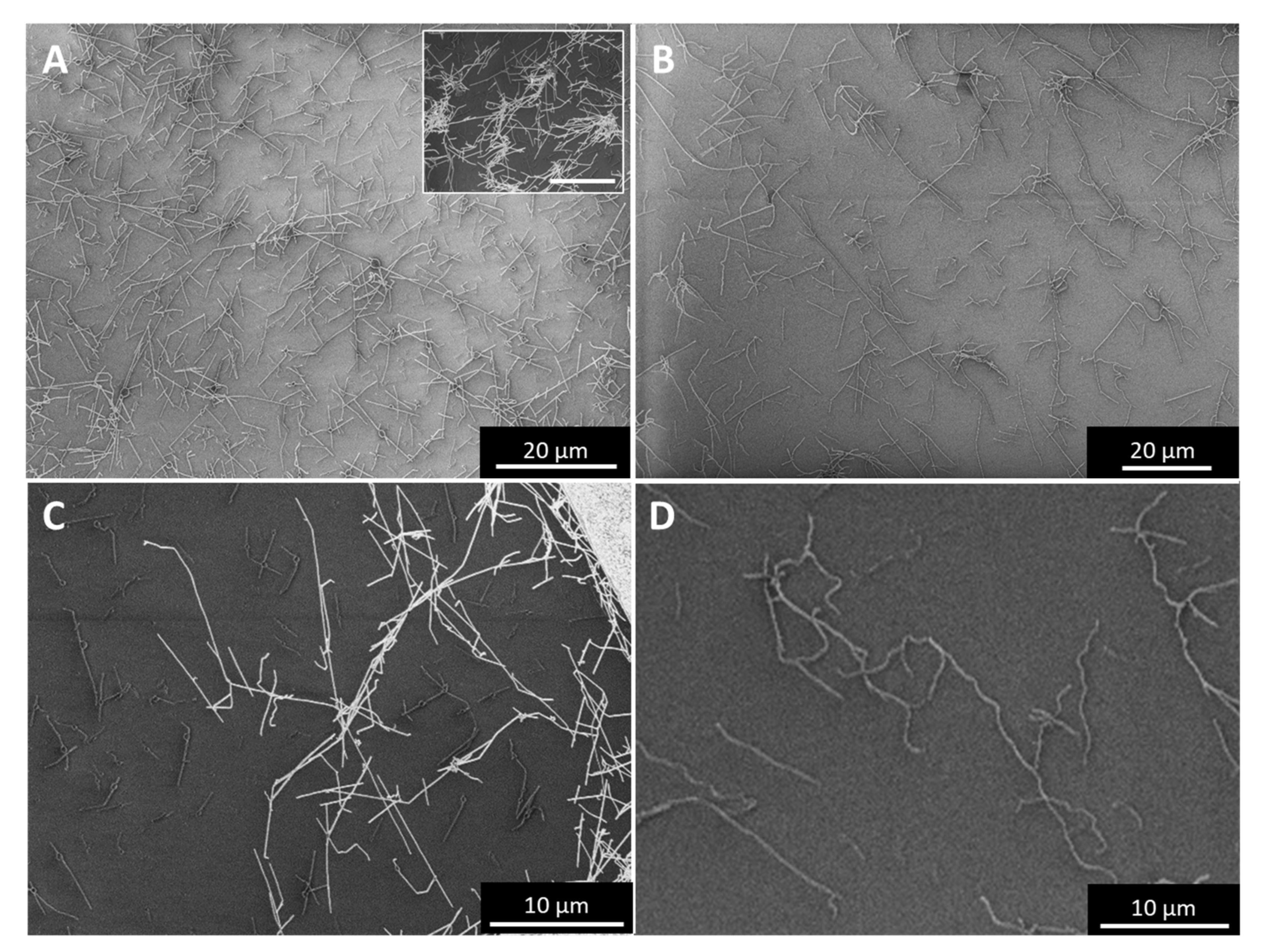

Appendix A.5. SEM, EDX–Elemental Analysis of Laser Treated CNT Films

| Atom % | Low H2 Spun, Boulders | High H2 Spun, Faceted Particles | High H2 Spun, Spherical Particles |
|---|---|---|---|
| C K | 59.8 | 61.1 | 40.3 |
| O K | 30.6 | 31.6 | 52.2 |
| Fe K | 6.3 | 7.3 | 2.7 |
| Ca K | 0.1 | - | 3.5 |
| Al K | 1.4 | - | 0.7 |
| Traces of Sample holder (Cu and/or Au) | 1.8 | - | 0.6 |
Appendix A.6. TEM–Elemental Analysis of Laser Treated CNT Films

Appendix A.7. Annular Ring or Hole Formation for Single Spot Laser Treatment of Wide Samples

Appendix A.8. Comparison of Commercial Camera Flashing and Industrial Flashing
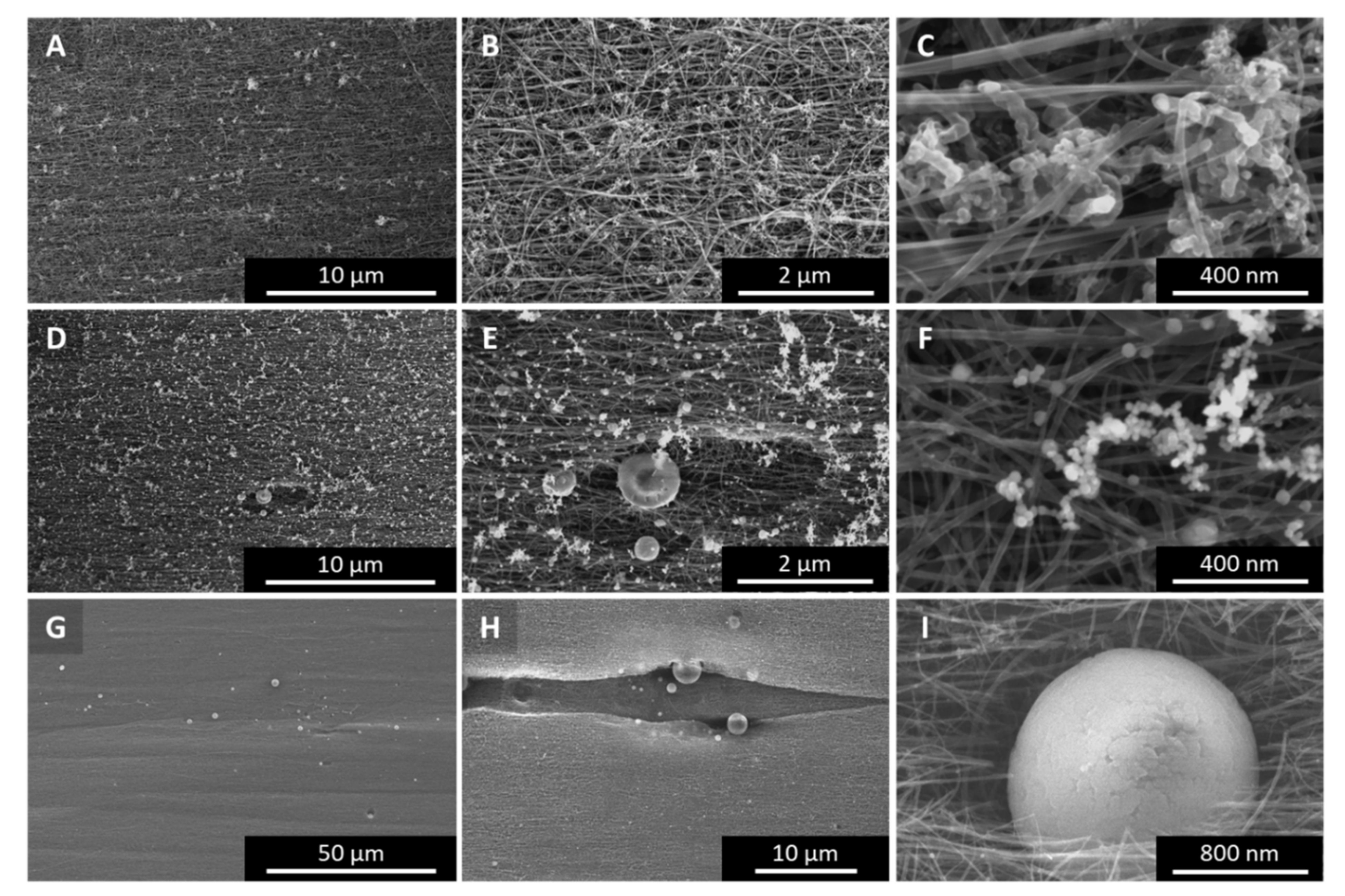
Appendix A.9. Joule Heating—Raman G:D Ratio Improvement around the Fracture Zone

Appendix A.10. Joule Heating—Folding in Particles for Fibres Spun from Benzyl Alcohol

References
- DeVolder, M.F.L.; Tawfick, S.H.; Baughman, R.H.; Hart, A.J. Carbon Nanotubes: Present and Future Commercial Applications. Science 2013, 339, 535–539. [Google Scholar] [CrossRef]
- Bulmer, J.; Kaniyoor, A.; Gspann, T.; Mizen, J.; Ryley, J.; Kiley, P.; Ratering, G.; Sparreboom, W.; Bauhuis, G.; Stehr, T.; et al. Forecasting continuous carbon nanotube production in the floating catalyst environment. Chem. Eng. J. 2020, 390, 124497. [Google Scholar] [CrossRef]
- Gspann, T.S.; Juckes, S.M.; Niven, J.F.; Johnson, M.B.; Elliott, J.A.; White, M.A.; Windle, A.H. High thermal conductivities of carbon nanotube films and micro-fibres and their dependence on morphology. Carbon 2017, 114, 160–168. [Google Scholar] [CrossRef]
- Stallard, J.; Tan, W.; Smail, F.; Gspann, T.; Boies, A.; Fleck, N. The mechanical and electrical properties of direct-spun carbon nanotube mats. Extrem. Mech. Lett. 2018, 21, 65–75. [Google Scholar] [CrossRef]
- Hone, J.; Llaguno, M.; Nemes, N.; Johnson, A.; Fischer, J.; Walters, D.; Casavant, M.; Schmidt, J.; Smalley, R. Electrical and thermal transport properties of magnetically aligned single wall carbon nanotube films. Appl. Phys. Lett. 2000, 77, 666–668. [Google Scholar] [CrossRef]
- Badaire, S.; Pichot, V.; Zakri, C.; Poulin, P.; Launois, P.; Vavro, J.; Guthy, C.; Chen, M.; Fischer, J.E. Correlation of properties with preferred orientation in coagulated and stretch-aligned single-wall carbon nanotubes. J. Appl. Phys. 2004, 96, 7509–7513. [Google Scholar] [CrossRef]
- Bulmer, J.S.; Mizen, J.E.; Gspann, T.S.; Kaniyoor, A.; Ryley, J.B.; Kiley, P.J.; Sparkes, M.R.; O’Neill, B.; Elliott, J.A. Extreme stretching of high G:D ratio carbon nanotube fibers using super-acid. Carbon 2019, 153, 725–736. [Google Scholar] [CrossRef]
- Koziol, K.; Vilatela, J.; Moisala, A.; Motta, M.; Cunniff, P. High-Performance Carbon Nanotube Fiber. Science 2007, 318, 1892. [Google Scholar] [CrossRef] [PubMed]
- Tran, C.D.; Humphries, W.; Smith, S.M.; Huynh, C.; Lucas, S. Improving the tensile strength of carbon nanotube spun yarns using a modified spinning process. Carbon 2009, 47, 2662–2670. [Google Scholar] [CrossRef]
- Bulmer, J.; Gspann, T.; Orozco, F.; Sparkes, M.; Koerner, H.; Bernardo, A.D.; Niemiec, A.; Robinson, J.; Koziol, K.; Elliott, J.; et al. Photonic Sorting of Aligned, Crystalline Carbon Nanotube Textiles. Sci. Rep. 2017, 7, 12977. [Google Scholar] [CrossRef]
- Liu, D.; Liu, Y.; Liu, G. Effects of carbon nanotubes additions on flash ignition characteristics of Fe and Al nanoparticles. Fuller. Nanotub. Carbon Nanostruct. 2018, 26, 168–174. [Google Scholar] [CrossRef]
- Ajayan, P.M.; Terrones, M.; de la Guardia, A.; Huc, V.; Grobert, N.; Wei, B.Q.; Lezec, H.; Ramanath, G.; Ebbesen, T.W. Nanotubes in a Flash—Ignition and Reconstruction. Science 2002, 296, 705. [Google Scholar] [CrossRef]
- Braidy, N.; Botton, G.A.; Adronov, A. Oxidation of Fe Nanoparticles Embedded in Single-Walled Carbon Nanotubes by Exposure to a Bright Flash of White Light. Nano Lett. 2002, 2, 1277–1280. [Google Scholar] [CrossRef]
- Kumar, M.; Rawat, N.; Santhanam, K. Effect of nanostructure on the thermal oxidation of atomized iron. In MRS Online Proceedings Library Archive; 0899-N07-01; Volume 899: Symposium N—Dynamics in Small Confining Systems VIII; Cambridge University Press: Cambridge, UK, 2005. [Google Scholar]
- Tseng, S.H.; Tai, N.H.; Hsu, W.K.; Chen, L.J.; Wang, J.H.; Chiu, C.C.; Lee, C.Y.; Chou, L.J.; Leou, K.C. Ignition of carbon nanotubes using a photoflash. Carbon 2007, 45, 958–964. [Google Scholar] [CrossRef]
- Carlucci, P.; Visconti, P.; Primiceri, P.; Strafella, L.; Ficarella, A.; Laforgia, D. Photo-Induced Ignition of Different Gaseous Fuels Using Carbon Nanotubes Mixed with Metal Nanoparticles as Ignitor Agents. Combust. Sci. Technol. 2017, 189, 937–953. [Google Scholar] [CrossRef]
- Visconti, P.; Primiceri, P.; Longo, D.; Strafella, L.; Carlucci, P.; Lomascolo, M.; Cretì, A.; Mele, G. Photo-ignition process of multiwall carbon nanotubes and ferrocene by continuous wave Xe lamp illumination. Beilstein J. Nanotechnol. 2017, 8, 134–144. [Google Scholar] [CrossRef]
- Kwon, Y.-K.; Berber, S.; Tomanek, D. Thermal Contraction of Carbon Fullerenes and Nanotubes. Phys. Rev. Lett. 2004, 92, 015901. [Google Scholar] [CrossRef] [PubMed]
- Tan, W.; Stallard, J.; Smail, F.; Boies, A.; Fleck, N. The mechanical and electrical properties of direct-spun carbon nanotube mat-epoxy composites. Carbon 2019, 150, 489–504. [Google Scholar] [CrossRef]
- Heo, Y.J.; Yun, C.H.; Kim, W.N.; Lee, H.S. The effect of mesoscopic shape on thermal properties of multi-walled carbon nanotube mats. Curr. Appl. Phys. 2011, 11, 1144–1148. [Google Scholar] [CrossRef]
- Ma, Y.J.; Yao, X.F.; Zheng, Q.S.; Yin, Y.J.; Jiang, D.J.; Xu, G.H.; Wei, F.; Zhang, Q. Carbon nanotube films change Poisson’s ratios from negative to positive. Appl. Phys. Lett. 2010, 97, 061909. [Google Scholar] [CrossRef]
- Li, Y.-L.; Kinloch, I.; Windle, A. Direct spinning of carbon nanotube fibers from chemical vapor deposition synthesis. Science 2004, 304, 276–278. [Google Scholar] [CrossRef] [PubMed]
- Gspann, T.S.; Smail, F.R.; Windle, A.H. Spinning of carbon nanotube fibres using the floating catalyst high temperature route: Purity issues and the critical role of sulphur. Faraday Discuss. 2014, 173, 47–65. [Google Scholar] [CrossRef]
- Kaniyoor, J.; Bulmer, T.; Gspann, J.; Mizen, J.; Ryley, P.; Kiley, J.; Terrones, C.; Miranda-Reyes, G.; Divitini, M.; Sparkes, B.; et al. High throughput production of single-wall carbon nanotube fibres independent of sulfur-source. Nanoscale 2019, 11, 18483–18495. [Google Scholar] [CrossRef]
- Feng, X.; Chee, S.W.; Sharma, R.; Xie, K.L.X.; Li, Q.; Fan, S.; Jiang, K. In Situ TEM Observation of the Gasification and Growth of Carbon Nanotubes Using Iron Catalysts. Nano Res. 2011, 4, 767–779. [Google Scholar] [CrossRef]
- Thiagarajan, V.; Wang, X.; Bradford, P.; Zhu, Y.; Yuan, F. Stabilizing carbon nanotube yarns using chemical vapor infiltration. Compos. Sci. Technol. 2014, 90, 82–87. [Google Scholar] [CrossRef]
- Kaniyoor, A.; Gspann, T.; Elliott, J. Bundle Alignment in Carbon Nanotube Yarns and 2D anisotropic systems. J. Appl. Polym. Sci. 2021. submitted. [Google Scholar]
- Mikhalchan, A.; Gspann, T.; Windle, A. Aligned carbon nanotube–epoxy composites: The effect of nanotube organization on strength, stiffness, and toughness. J. Mater. Sci. 2016, 51, 10005–10025. [Google Scholar] [CrossRef]
- Cranford, S.; Yao, H.; Ortiz, C.; Buehler, M.J. A single degree of freedom “lollipop” model for carbon nanotube bundle formation. J. Mech. Phys. Solids 2010, 58, 409–427. [Google Scholar] [CrossRef]
- Wang, Y.; Xu, H.; Drozdov, G.; Dumitrica, T. Mesoscopic friction and network morphology control the mechanics and processing of carbon nanotube yarns. Carbon 2018, 139, 94–104. [Google Scholar] [CrossRef]
- Li, S.; Park, J.G.; Liang, Z.; Siegrist, T.; Liu, T.; Zhang, M.; Cheng, Q.; Wang, B.; Zhang, C. In situ characterization of structural changes and the fraction of aligned carbon nanotube networks produced by stretching. Carbon 2012, 50, 3859–3867. [Google Scholar] [CrossRef]
- Volkov, N.; Zhigilei, L.V. Mesoscopic Interaction Potential for Carbon Nanotubes of Arbitrary Length and Orientation. J. Phys. Chem. C 2010, 114, 5513–5531. [Google Scholar] [CrossRef]
- Ostanin, I.; Ballarini, R.; Dumitricə, T. Distinct element method for multiscale modeling of cross-linked carbon nanotube bundles: From soft to strong nanomaterials. J. Mater. Res. 2014, 30, 19–25. [Google Scholar] [CrossRef]
- Plimpton, S. Fast Parallel Algorithms for Short-Range Molecular Dynamics. J. Comput. Phys. 1995, 117, 1–19. [Google Scholar] [CrossRef]
- Shirasu, K.; Yamamoto, G.; Tamaki, I.; Ogasawara, T.; Shimamura, Y.; Inoue, Y.; Hashida, T. Negative axial thermal expansion coefficient of carbon nanotubes: Experimental determination based on measurements of coefficient of thermal expansion for aligned carbon nanotube reinforced epoxy composites. Carbon 2015, 95, 904–909. [Google Scholar] [CrossRef]


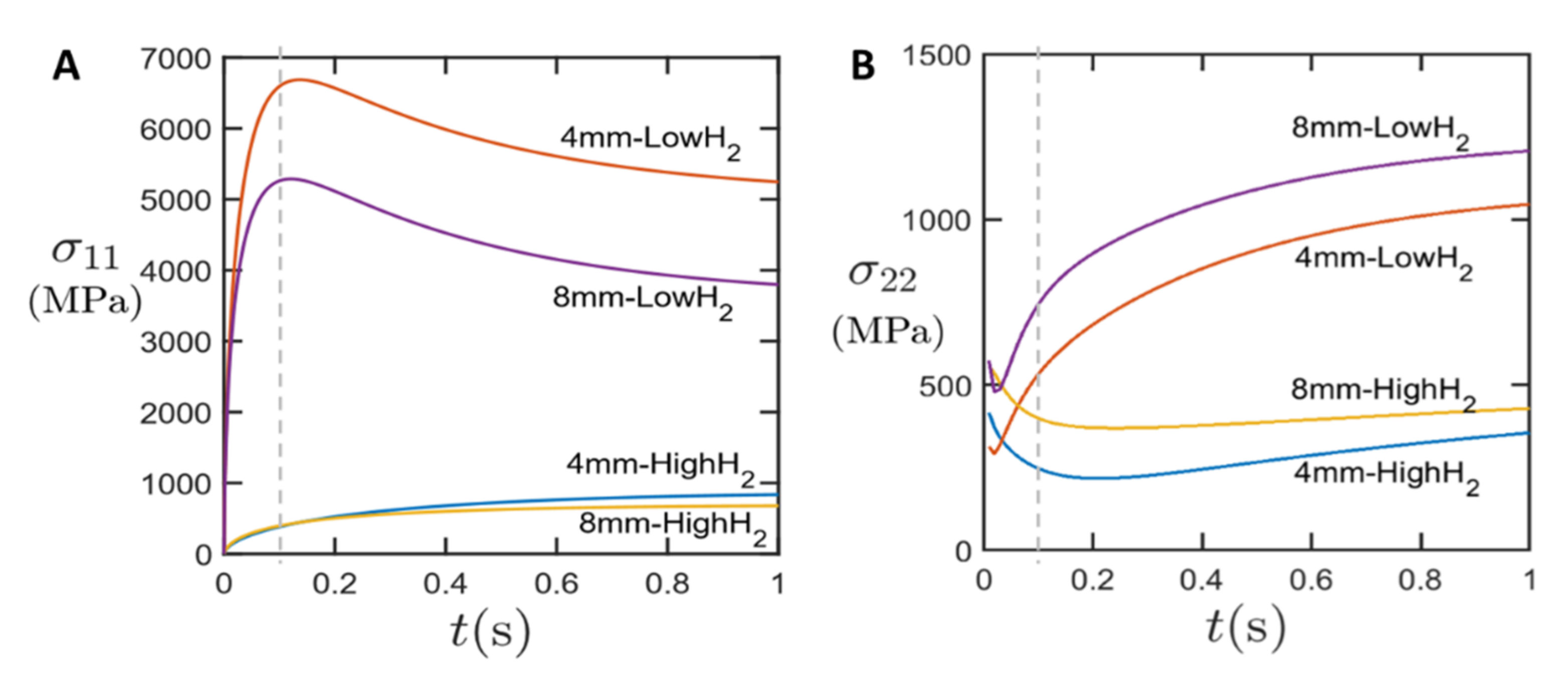




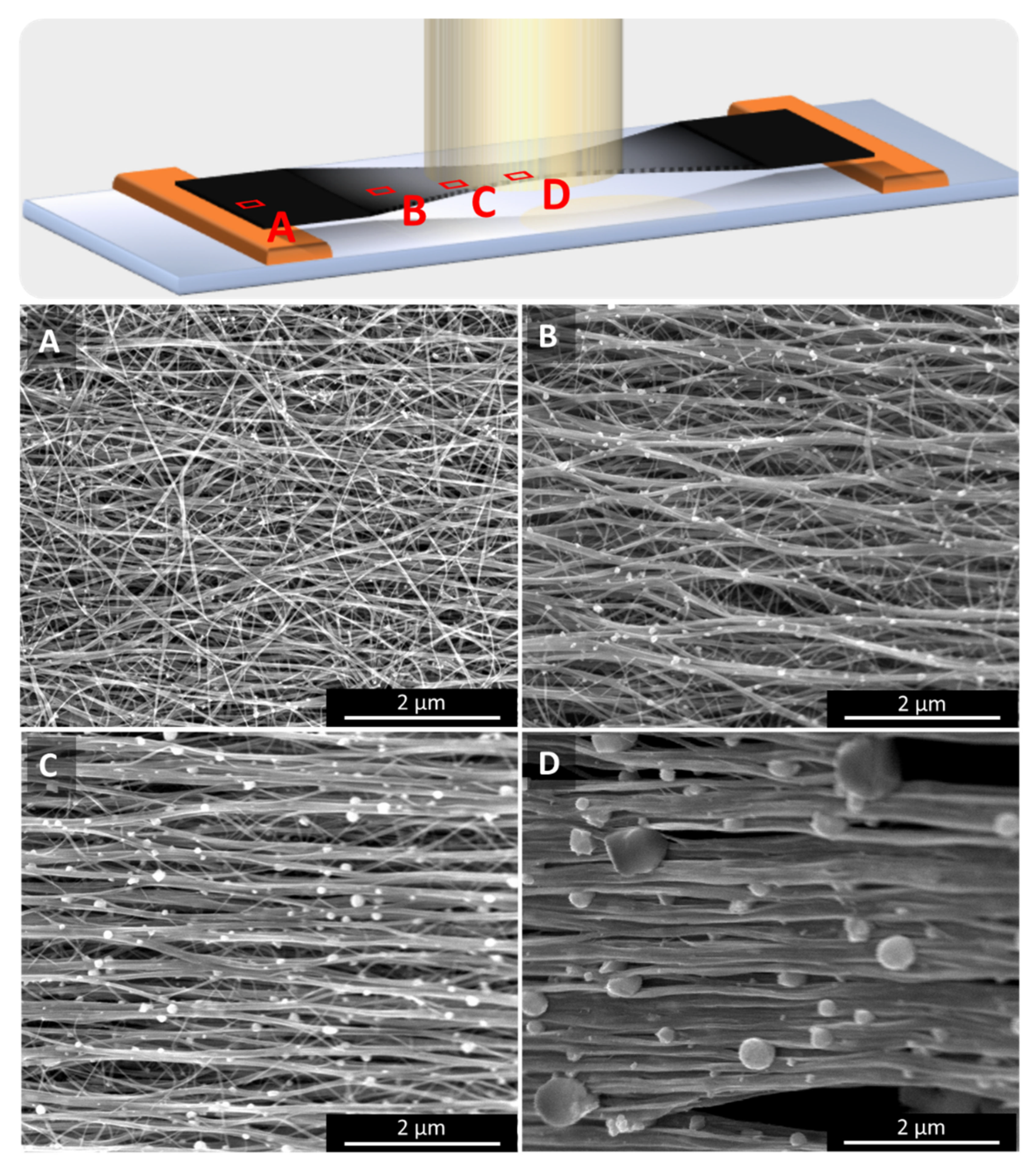

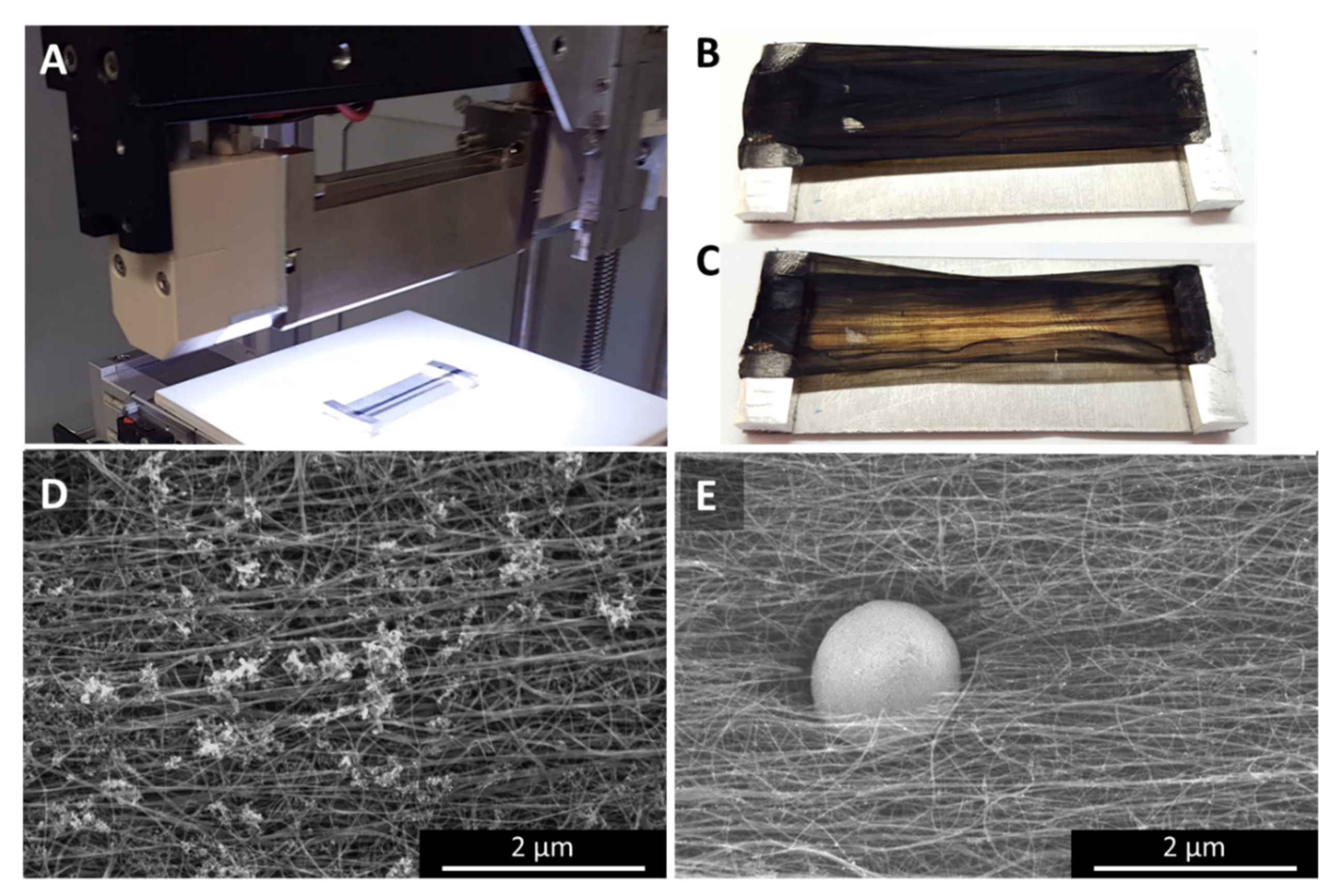

| Element | Large NP in “Low H2”-Spun Material, After Laser Treatment [wt%] | Small NP in “Low H2”-Spun Material, After Laser Treatment [wt%] | NP in “High H2”-Spun Material, After Laser Treatment [wt%] |
|---|---|---|---|
| C (K) | 47.59 ± 0.2 | 52.01 ± 0.2 | 38.68 ± 0.2 |
| O (K) | 15.01 ± 0.1 | 15.08 ± 0.1 | 11.51 ± 0.1 |
| Si (K) | 18.79 ± 0.1 | 20.77 ± 0.1 | 1.97 ± 0.1 |
| S (K) | 0.12 ± 0.1 | 0.06 ± 0.1 | - |
| Ca (K) | 2.08 ± 0.1 | 0.03 ± 0.1 | - |
| Fe (K) | 0.57 ± 0.1 | 0.44 ± 0.1 | 14.65 ± 0.1 |
| Cu (K) | 15.81 ± 0.1 | 11.59 ± 0.1 | 33.16 ± 0.1 |
| A | B | C | D | |
|---|---|---|---|---|
| Chebyshev Orientation Parameter T2 | 0.45 ± 0.02 | 0.49 ± 0.01 | 0.61 ± 0.01 | 0.68 ± 0.01 |
| FWHM of FFT Intensity Distribution [°] | 48.8 ± 2.2 | 43.5 ± 2.6 | 27.6 ± 0.7 | 20.5 ± 0.5 |
| Bundle Diameter [nm] | 23 ± 10 | 31 ± 18 | 36 ± 23 | 53 ± 33 |
| Input Parameter | Unit | ‘High H2′-Spun Material | ‘Low H2′-Spun Material | Ref. |
|---|---|---|---|---|
| Laser Temperature | K | 1473 | [10] | |
| CNT film density | kg m−3 | 20 ± 3 | 340 ± 60 | [3] |
| Young’s Modulus (long.) | GPa | 10 ± 2 | 78 ± 8 | [3] |
| Young’s Modulus (transv.) | GPa | 5 | 8 | from anisotropy |
| Thermal expansion coefficient (long.) | - | −3.0 10−4 | [35] | |
| Thermal expansion coefficient (transv.) | - | −1.5 10−4 | −3.0 10−5 | from anisotropy |
| Specific heat capacity | J (K kg)−1 | 609.25 | [20] | |
| Thickness | µm | 9.8 ± 0.8 | 3.1 ± 0.4 | [3] |
| Poisson’s ratio | - | 0.3 | [21] | |
| Anisotropy | - | 2 ± 0.5 | 10 ± 1 | [2], ratio of electrical conductivity measured along/perpendicular to bundle alignment |
Publisher’s Note: MDPI stays neutral with regard to jurisdictional claims in published maps and institutional affiliations. |
© 2021 by the authors. Licensee MDPI, Basel, Switzerland. This article is an open access article distributed under the terms and conditions of the Creative Commons Attribution (CC BY) license (http://creativecommons.org/licenses/by/4.0/).
Share and Cite
Gspann, T.S.; Kaniyoor, A.; Tan, W.; Kloza, P.A.; Bulmer, J.S.; Mizen, J.; Divitini, G.; Terrones, J.; Tune, D.; Cook, J.D.; et al. Catalyst-Mediated Enhancement of Carbon Nanotube Textiles by Laser Irradiation: Nanoparticle Sweating and Bundle Alignment. Catalysts 2021, 11, 368. https://doi.org/10.3390/catal11030368
Gspann TS, Kaniyoor A, Tan W, Kloza PA, Bulmer JS, Mizen J, Divitini G, Terrones J, Tune D, Cook JD, et al. Catalyst-Mediated Enhancement of Carbon Nanotube Textiles by Laser Irradiation: Nanoparticle Sweating and Bundle Alignment. Catalysts. 2021; 11(3):368. https://doi.org/10.3390/catal11030368
Chicago/Turabian StyleGspann, Thurid S., Adarsh Kaniyoor, Wei Tan, Philipp A. Kloza, John S. Bulmer, Jennifer Mizen, Giorgio Divitini, Jeronimo Terrones, Daniel Tune, John D. Cook, and et al. 2021. "Catalyst-Mediated Enhancement of Carbon Nanotube Textiles by Laser Irradiation: Nanoparticle Sweating and Bundle Alignment" Catalysts 11, no. 3: 368. https://doi.org/10.3390/catal11030368
APA StyleGspann, T. S., Kaniyoor, A., Tan, W., Kloza, P. A., Bulmer, J. S., Mizen, J., Divitini, G., Terrones, J., Tune, D., Cook, J. D., Smail, F. R., & Elliott, J. A. (2021). Catalyst-Mediated Enhancement of Carbon Nanotube Textiles by Laser Irradiation: Nanoparticle Sweating and Bundle Alignment. Catalysts, 11(3), 368. https://doi.org/10.3390/catal11030368







